|
BEIJING (Day 1 - part 3)
After the Summer Palace, it was a stop at the Bang Fu Chun Pearl Store. China produces 95% of the freshwater pearls in the world, over 1,500 tons per year.
Almost any shelled mollusk can produce some kind of 'pearl' when an irritating microscopic object becomes trapped within its mantle (or shell-producing layer), but most of these are not valued as gemstones. Nacreous pearls, the kind we know best, are primarily produced by two different groups. Pearl oysters live in the sea, while river mussels live in freshwater.
A 'natural pearl' is one that forms in the wild without any human intervention. It is very rare. Many hundreds of pearl oysters or mussels had to be gathered and opened, and thus killed, in order to find even one wild pearl. For many centuries this was the only way pearls were obtained which contributed to their high value and price. A cultured pearl, on the other hand, is grafted on a pearl farm and can produce up to 30 pearls per mussel.
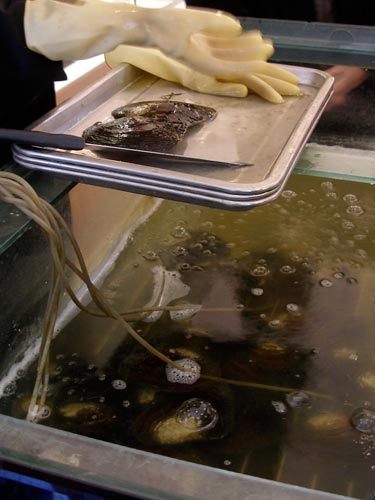
The Triangle Shell Mussel is most commonly used today.
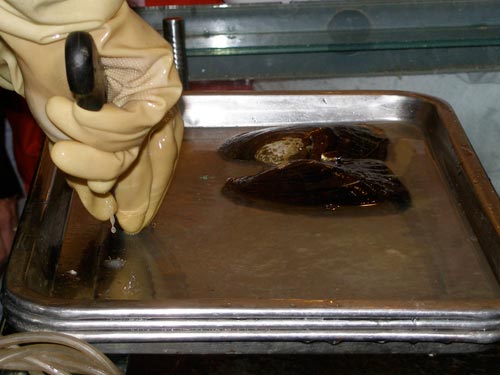
Cutting open the mussel. A mussel's age can be determined by counting its rings. Six years old is still a baby.
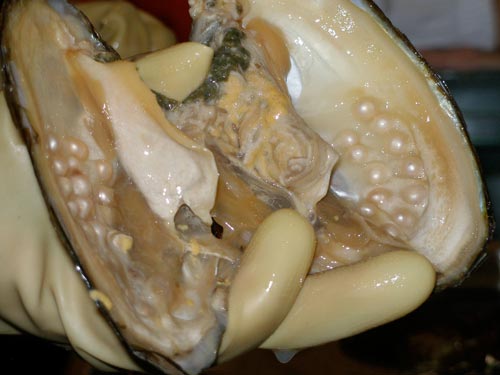
The rewards inside. The meat from this mussel will be embedded into the mantles of baby mussels. The resulting irritation will eventually form new pearls.
Pearls from the sea are valued more highly than freshwater pearls. Ocean oysters are oval-shaped and contain only one pearl. Freshwater mussels are triangle-shape and contain many pearls.
Imitation pearls are also widely sold. Fake pearls are smooth; real ones are grainy and gritty. When two real pearls are rubbed together, they will produce a white powder (even with black pearls).
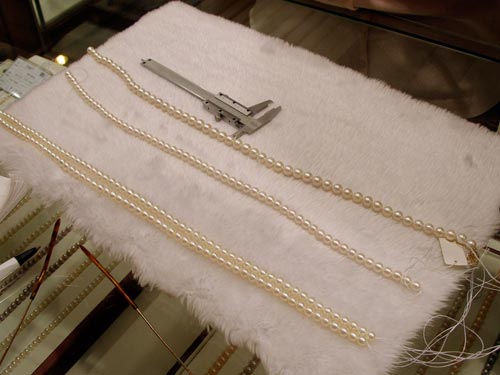
Calipers measure the pearl size in millimeters.
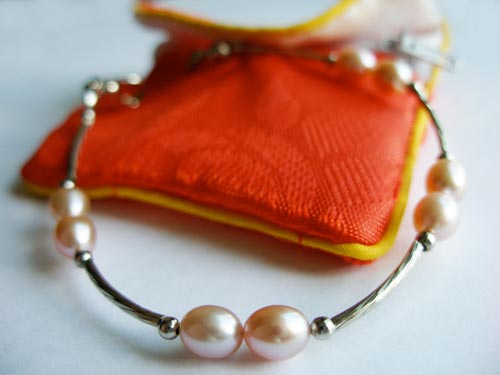
A pink pearl bracelet. Every purchase comes with its own little jewelry bag.
Pearls come in a variety of colors based on their mineral content: white (calcium), pink (copper), purple or black (iron).
They also come in eight basic shapes: round, semi-round, button, drop, pear, oval, baroque, and circled. Small irregular-sized pearls are ground into pearl creams. Ocean pearls can not be ingested as they contain mercury.

Stringing the pearls into necklaces is very delicate work.
Knots are tied between pearls to keep them from rubbing against each other and damaging their nacre (the irridescent layer on the surface). Knots also act as security stoppers - if a strand breaks, you might lose one or two but the knots will prevent most of the pearls from falling off. Inexpensive fashion pearls are not typically strung with knots between them.
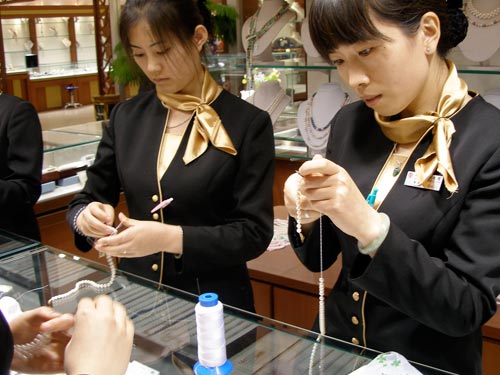
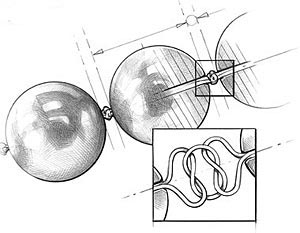
The pearl knot
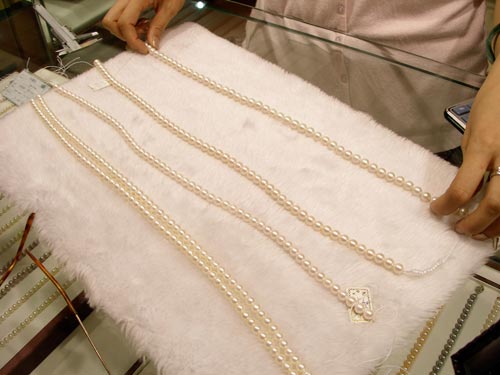
The beautiful finished products
After a quick lunch, we set out for Tian'anmen Square and the Forbidden City.
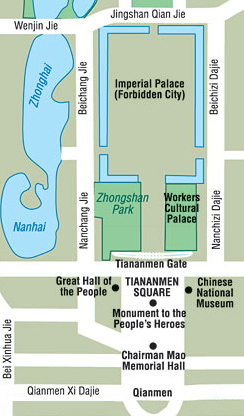
With Tian'anmen Square as its southern entrance, the Forbidden City was the Chinese imperial palace from the Ming to Qing Dynasties (1368 - 1911).
Tiananmen Square is the largest downtown square in the world. It covers an area of 44 hectares, big enough to hold one million people. It is named after the Gate of Heavenly Peace at its northern end.
Tian (heaven) - an (peace) - men (gate)
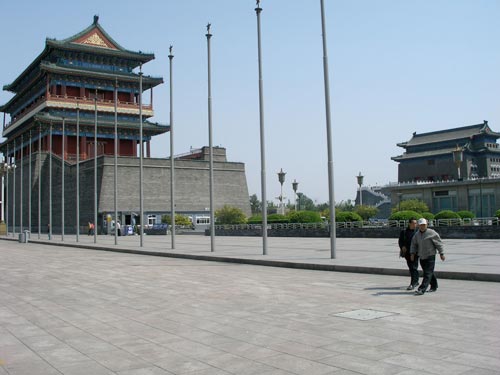
The Front Gate (left) and Arrow Gate. Some of the old city gates still remain, although the city wall is long gone.
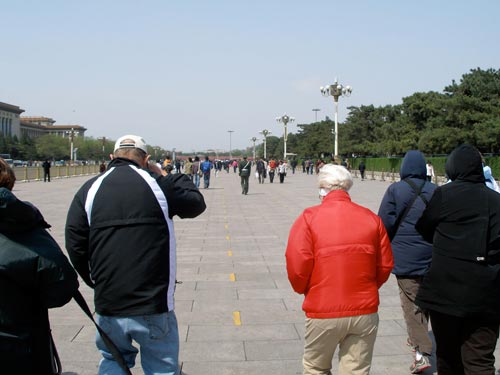
The cold wind joins us on the long walk to the square.
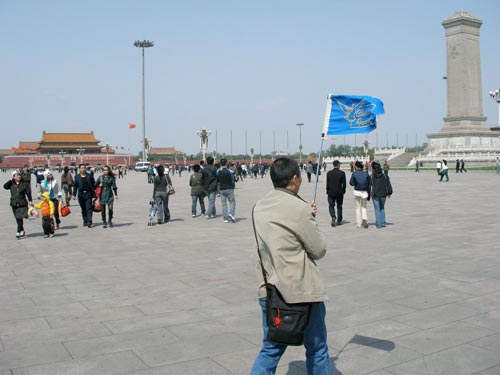
Tony carries the China Focus flag. To the right is the Monument to the People's Heros (1959), similar to the tomb of the unknown soldier.
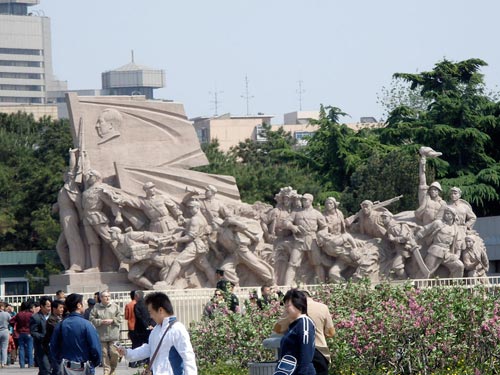
This statue marks the entrance to the Chairman Mao Memorial Hall.
Mao Zedong or Mao Tse-tung (1893 - 1976) led the Communist Party of China to victory against the Kuomintang in the Chinese Civil War, and was the leader of the People’s Republic of China from its establishment in 1949 until his death. Mao remains a controversial figure to this day. Some hold him in high regard as a great revolutionary, political strategist and military mastermind, who through his policies transformed the country into a major world power. Others blame many of his socio-political programs, such as the Great Leap Forward and the Cultural Revolution, for causing severe damage to the culture, society, economy and foreign relations of China.
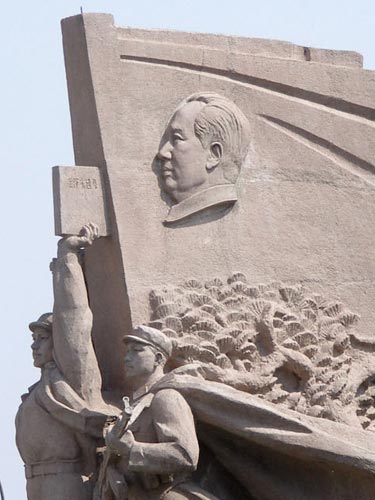
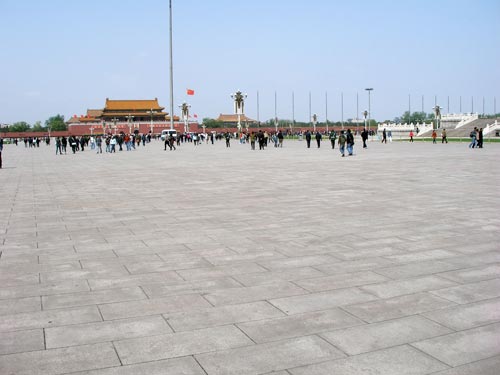
Looking across the square toward Gate of Heavenly Peace

The Great Hall of the People, on the western side of the square, functions as the country's parliament building.
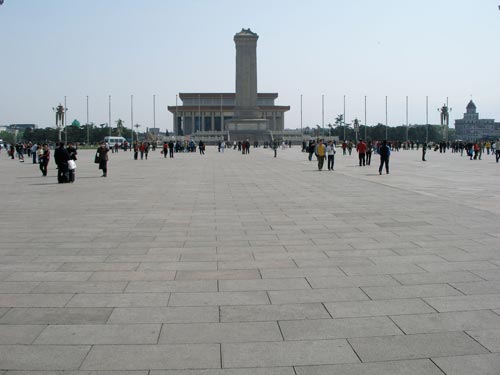
Looking back down the square at the Monument to the People's Heros and the Chairman Mao Memorial Hall.
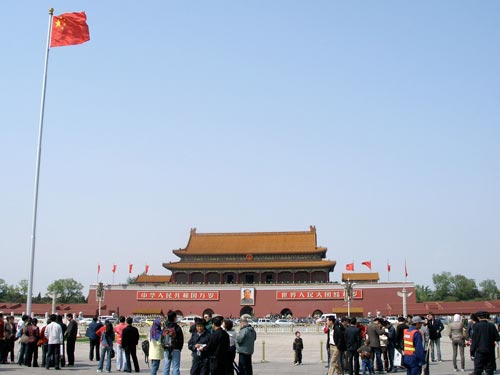
China's national flag was first flown in the square on October 1, 1949 - the day of the founding of the People's Republic of China.

The red background symbolizes the blood of heroes who died during the revolution, and the golden color is for the glorious history and culture of the Chinese people. The larger star symbolizes the leadership of the Communist Party of China, and the four smaller stars are for the four classes: famers, workers, soldiers, and teachers.
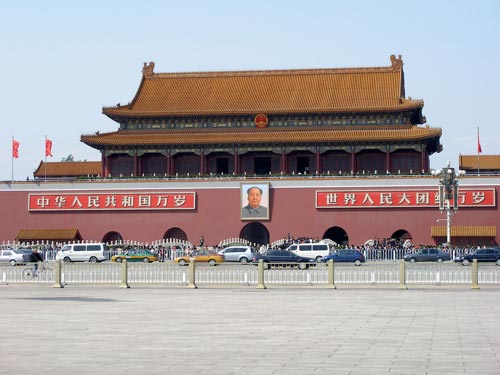
Mao's portrait has hung on the Gate of Heavenly Peace since 1949. The left side reads "Long Live Chairman Mao."
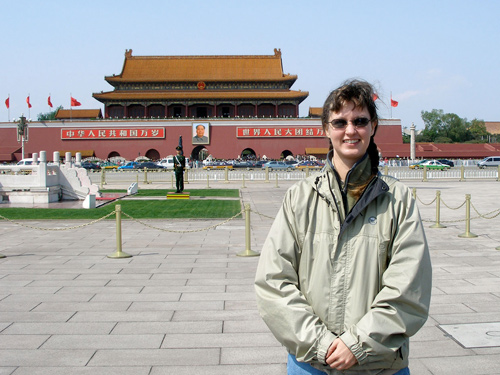
Me in front of the gate

For a mere $3, one could even get a Mao watch, complete with waving hand, from the countless square vendors.
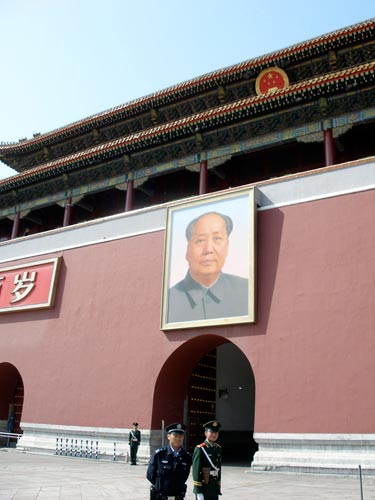
Once through this gate, we begin our journey into the Forbidden City.
For almost five centuries until the early 1900s, the Forbidden City served as the home of the Emperor and his household, as well as the ceremonial and political center of Chinese government. Built from 1406 to 1420, the complex consists of 980 surviving buildings and covers 7,800,000 square feet.
The Chinese name, Zijin Cheng, is more literally translated as Purple Forbidden City. Zi (or purple) refers to the North Star, the center of the cosmos, which in traditional Chinese astrology was the abode of the Celestial Emperor. The Forbidden City, as the residence of the terrestrial emperor, was its earthly counterpart. Jin (Forbidden) referred to the fact that no one could enter or leave the palace without the emperor's permission. Cheng means a walled city. Today, the site is most commonly known in Chinese as Gugong (Former Palace). Since 1925, it has been under the charge of the Palace Museum, whose extensive collection is built upon the imperial collections of the Ming and Qing dynasties.
The Forbidden City was begun by the Yongle Emperor (Zhu Di), the third emperor of the Ming Dynasty from 1402 to 1424. Yongle means Perpetual Happiness, and he is generally considered to be one of the greatest Chinese emperors.
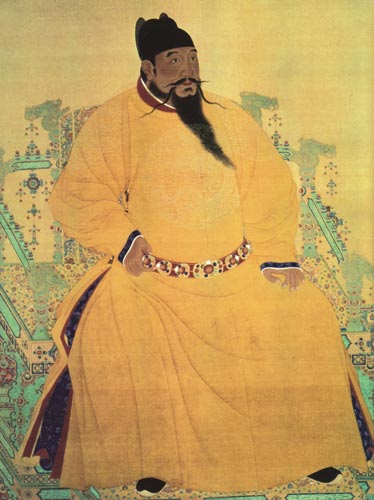
The Yongle Emperor (1360 - 1424)
His father, the Hongwu Emperor, had moved the capital away from Beijing upon the establishment of the Ming Dynasty and destroyed all the palaces that had belonged to the previous dynasty, the Yuan Dynasty of the Mongols. But when Zhu Di became emperor, he moved back to Beijing, and construction began in 1406 of what would become the Forbidden City. Construction lasted 15 years and required more than a million workers. The complex contains 9,999.5 rooms, which is half a room less than the 1000 rooms heaven was believed to be.
After being the home of 24 emperors (14 of the Ming Dynasty and 10 of the Qing Dynasty), the Forbidden City ceased being the political centre of China in 1912.
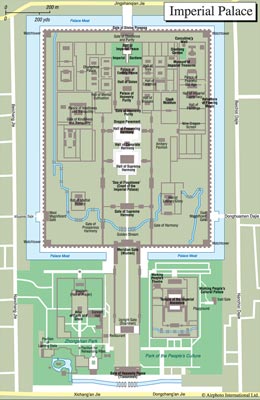
Click to enlarge
After passing through the Gate of Heavenly Peace at Tian'anmen square, we approach the southern gates of the Forbidden City.

The Upright Gate (Duanmen):
For most emperors, the Forbidden City was an opulant palace. For one, it was literally a prison. Puyi (1906 - 1967) was the twelfth and final member of the Qing Dynasty to rule over China, reining from 1908 - 1912. Chosen by Dowager Empress Cixi while on her deathbed, Puyi ascended the throne at the age of two. He was titled the Xuantong Emperor. Overnight, he was treated as a god. But his reign was short-lived. Following the Xinhai Revolution in 1912, Puyi was removed from power. He was, however, allowed to continue living in the Forbidden City until 1924. That said, he was also not allowed to set foot outside of its walls either.
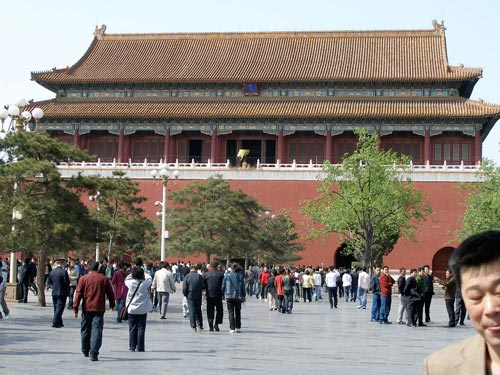
The Upright Gate was as far as the Last Emperor was allowed to go in his prison.
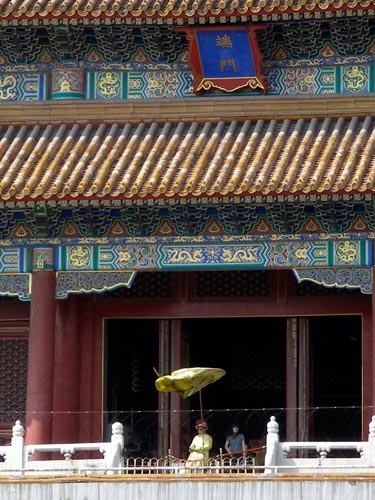
Here he sits, wearing the imperial color of yellow, gazing into a land that was not his.

The real Puyi
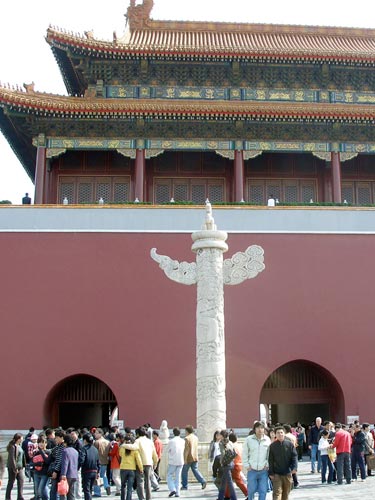
Each palace had pillars where people could post their opinions. But one emperor didn't like this tradition so he made them out of marble so nothing could be posted (this is apparently in the days before tape).
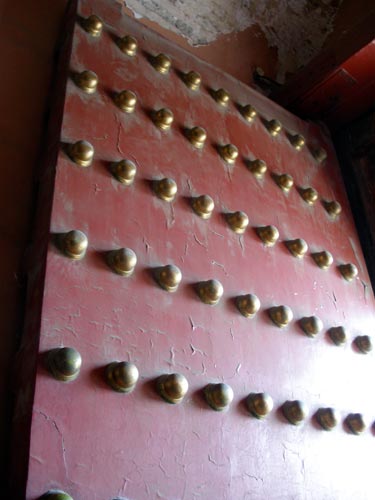
Each door has 9 rows of 9 golden knobs.
In Chinese culture, the color red usually means good luck, wealth and happiness. Red gates also keep evil spirits away. Yellow became an imperial color during the Tang dynasty, when only members of the royal family were allowed to wear it and use it in their architecture. According to the theory of Five Elements in ancient China, yellow refers to the earth that occupies the central position, thereby representing supreme royal power. Numbers are also seen as lucky or unlucky. This is partly based on how similar they sound to other Chinese words.
Some lucky numbers include:
|
2
|
'good things come in pairs'. It is common to use double symbols such as Double Happy, etc. It also sounds like 'easy'. |
|
3
|
sounds similar to the character for 'birth'. |
| 5 |
is associated with the five elements (water, wood, fire, earth and metal) in Chinese philosophy, and in turn was historically associated with the emperor. Many of the palace gates have five arches. |
| 9 |
is the greatest of single-digit numbers, sounding the same as 'longlasting'. It was historically associated with the emperor. |
Some unlucky numbers include:
|
4
|
sounds like the word 'death', hence it is often avoided... even to the point of some buildings not having a 4th floor. |
|
7
|
is considered for spirits or ghostly. |
The Meridian Gate (Wumen):
This main entrance to the Forbidden City was so named because the emperor believed that his residence was the center of universe and that the meridian line went right though the city. The gate was first built in 1420 and rebuilt in 1647. It was the place to announce the new lunar calendar, to celebrate victories and accept prisoners of war, and where emperors in the Ming Dynasty (1368 - 1644) would punish offending officials by beating them with sticks.
The gate is sometimes called the Five Phoenix Tower. Drums (on the east) and bells (on the west) were installed in the towers to announce when the emperor went to the Temple of Heaven and when he offered sacrifices to the deceased emperors in the Ancestral Temple.
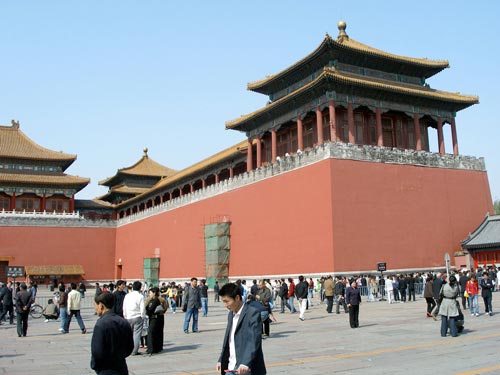
The entire city is surrounded by a 26-foot high wall that is 28 feet wide at the base and 22 feet wide at the top. The city moat used to pass in front of this gate. Now it runs under the courtyard.
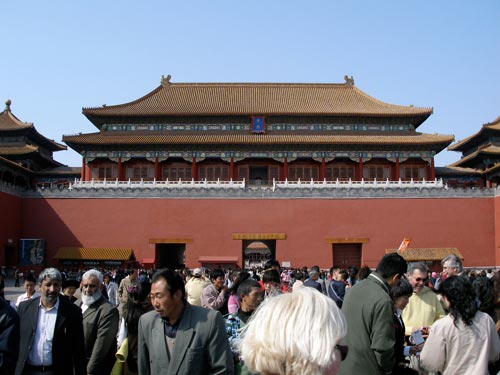
The gate has five openings. The central one was only for the emperor. High-ranking civil and military officials went through the side gate on the east and royal family members on the west. Further side gates were for the low-ranking officials. The empress was granted the privilege of using the central entrance only once, on her wedding day.
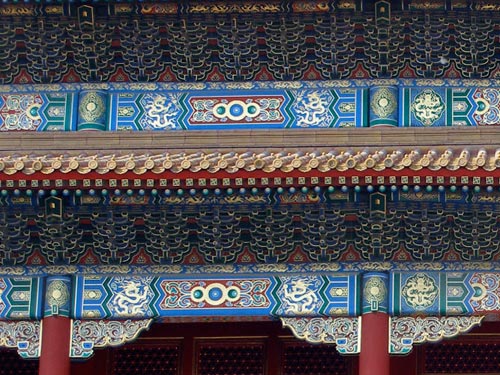
The decorations were exquisite.
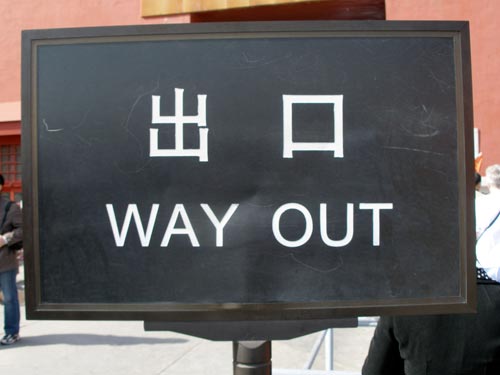
"Exit"
|
|

